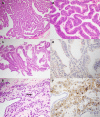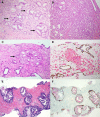WHO Classification of Tumours fifth edition: evolving issues in the classification, diagnosis, and prognostication of prostate cancer
- PMID: 35758185
- PMCID: PMC9542779
- DOI: 10.1111/his.14711
WHO Classification of Tumours fifth edition: evolving issues in the classification, diagnosis, and prognostication of prostate cancer
Abstract
The fifth edition of the WHO Classification of Tumours of the Urinary and Male Genital Systems encompasses several updates to the classification and diagnosis of prostatic carcinoma as well as incorporating advancements in the assessment of its prognosis, including recent grading modifications. Some of the salient aspects include: (1) recognition that prostatic intraepithelial neoplasia (PIN)-like carcinoma is not synonymous with a pattern of ductal carcinoma, but better classified as a subtype of acinar adenocarcinoma; (2) a specific section on treatment-related neuroendocrine prostatic carcinoma in view of the tight correlation between androgen deprivation therapy and the development of prostatic carcinoma with neuroendocrine morphology, and the emerging data on lineage plasticity; (3) a terminology change of basal cell carcinoma to "adenoid cystic (basal cell) cell carcinoma" given the presence of an underlying MYB::NFIB gene fusion in many cases; (4) discussion of the current issues in the grading of acinar adenocarcinoma and the prognostic significance of cribriform growth patterns; and (5) more detailed coverage of intraductal carcinoma of prostate (IDC-P) reflecting our increased knowledge of this entity, while recommending the descriptive term atypical intraductal proliferation (AIP) for lesions falling short of IDC-P but containing more atypia than typically seen in high-grade prostatic intraepithelial neoplasia (HGPIN). Lesions previously regarded as cribriform patterns of HGPIN are now included in the AIP category. This review discusses these developments, summarising the existing literature, as well as the emerging morphological and molecular data that underpins the classification and prognostication of prostatic carcinoma.
Keywords: WHO Classification; pathology; prostate carcinoma.
© 2022 The Authors. Histopathology published by John Wiley & Sons Ltd.
Conflict of interest statement
The authors do not report any conflicts of interest.
Figures


References
-
- Sung H, Ferlay J, Siegel RL et al. Global cancer statistics 2020: Globocan estimates of incidence and mortality worldwide for 36 cancers in 185 countries. CA Cancer J. Clin. 2021; 71; 209–249. - PubMed
-
- Netto GJ, Amin MB, Kench JG et al. Chapter 4: Tumours of the prostate. In Srigley JR, Amin MB, Rubin MA, Tsuzuki T, eds. WHO classification of tumours: Urinary and male genital tumours. Lyon, France: International Agency for Research on Cancer, 2022. https://tumourclassification.iarc.who.int/chapters/36
-
- Eble JNSG, Epstein JI, Sesterhenn IA. World Health Organization classification of tumours. Pathology and genetics of tumours of the urinary system and male genital organs. Lyon, France: IARC Press, 2004.
-
- Moch HHP, Ulbright TM, Reuter V. The WHO classification of tumours of the urinary system and male genital organs. Lyon, France: IARC Press, 2016.
Publication types
MeSH terms
Substances
Grants and funding
LinkOut - more resources
Full Text Sources
Medical
Miscellaneous

